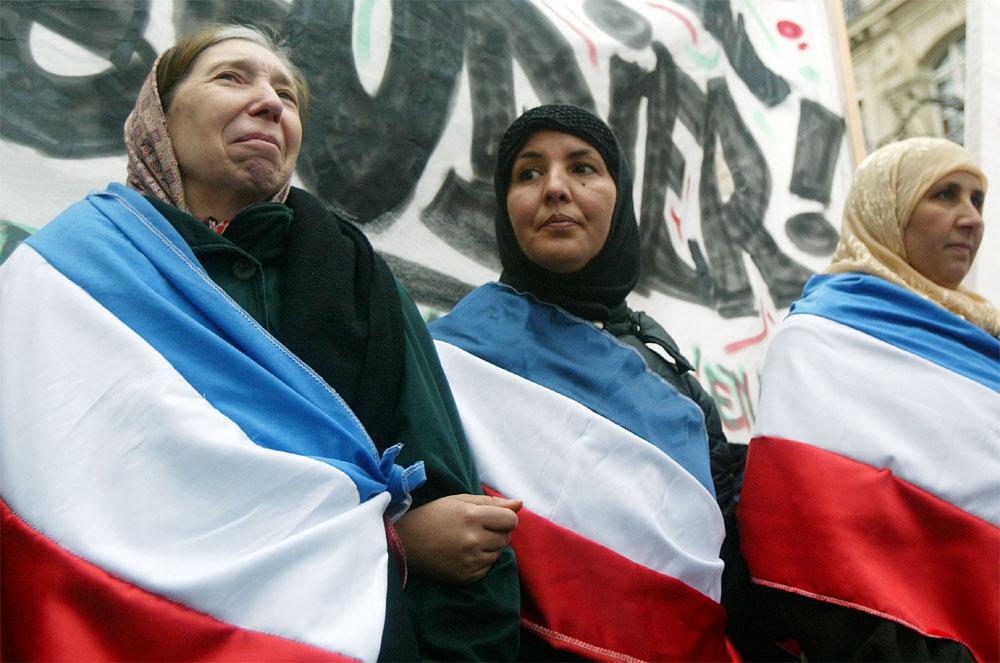
It has been a while since we heard from our media guy, Talal Chami. Who hosts an exceptional section on the website The Axles of my Wagon Wheels, dedicated to his, somehow, bizarre mind flicks. His Liberum silence came to a halt.
It all started when the French government passed a law in 2004 banning the wearing of ‘conspicuous signs ’ in public schools. Veil-related incidents took place on three different occasions, prompting a wave of controversies that were harshly felt across the nation and beyond.
By Talal Chami
According to Scott, France had failed once again to deal with its citizens! The author argues that the symbolic act of “banning” the veil, which, in turn, represented “a threat to national integrity and harmony,” was discriminatory and racist by all standards. “
It violated the separation of Church and the State, Laïcité [ and ] insisted on differences among citizens, in a nation one and indivisible and accepted the subordination of women in the Republic.” The voile controversy was a kind of “political hysteria” – that generated inflated debates without a defined, “concrete social policy.”(p.120) The issue of marginal French citizens – was more an issue of external pressure and Islamism –to avoid bearing any responsibility on the part of politicians who’d “display blame elsewhere.” (p. 119 )
In short, French social and racial problems were “blamed” on immigrants and their stubborn refusal to integrate on the inherent, “ foreignness “ of their culture.” (p.120 ). She makes it clear: It is not a book about Muslims’ rather about the dominant French view of them.”(p. 10)
Regarding the issue of integration in French society, there is no one choice to make between national identity and spiritual commitments; one complements the other. The difference is in Jean-Luc Nancy’s argument “exactly what constitutes our ‘being-in-common.” (p. 47)
This helps to understand that the voile is a [strictly] French phenomenon. It is essential to underline that the law acted as a triggering mechanism that rendered integration non-negotiable.
Abandoning Islam was a “clear condition” to embrace Frenchness.” It was evident in the chapters on individuality and sexuality. The colonizer/civilizer felt he had a civilized mission all along. The veil –Scott argues- was interpreted as a sign of “aggression, defiance” whether it connotes excessive sexuality or a denial of it ( p. 89 ) Sexuality was ever-present.
The inability of the ‘girls’ who were different, to interact with their opposites disturbed the “French, “and once again, it frustrated them outside a colonial context. French singularity as “a distinctive French form of sexuality …. was under threat.” (p.161)
The “ [girls] at once invoked individualism in terms familiar to republican discourse and spiritual commitments that [rested] on a very different notion of individual choice.” (p.141) In a series of interviews (published in books later) informed that “what they are after seems more often an abandonment of ego than an assertion of it; at the same time, the self is very much at the center of how they conceived of what they do.” –The voile is a “primary deed (virtuous) in the words of Mahmoud.
It is mandatory in Islam. Kada says, “It is one of the steps taken in the construction of one’s spiritual relationship …. [ One is a Muslim first; ] one adheres to a certain philosophy of life and, in this context, one wants to wear the headscarf.” (p.143) She argues that the aggressive behavior and political campaign against the veil was a sign “of the impotence and unwillingness of the government to address the problem …. [ on ] how to adjust to national institutions and ideologies that assume or seek to produce homogeneity to the heterogeneity of their current population.” (p. 40)
Islam was not only an ideology but also a culture, As we will see in the racism part of this book. It caused segregation, separation, and social divisions –and the veil was a visible sign of such separation. Her project concerns critical questions on negotiating differences and how individuals and groups with different interests can live together. In practice, “it is sameness, achieved through cultural assimilation, that guarantees national unity.”(p. 118).
It is pretty unclear how the campaign against the veil turns out to be a sign of impotence -Again, they did not doubt address the issue from a founding conviction impossible to overrule. Their act is righteous.
The veil had many confusing meanings: A tie to tradition. A mode of controlling sexuality. And a form of self-protection or [ even ] expression of identity. The girls could connect to an ‘imagined community’ with which they identified. You could be a Muslim and a “French” in that context. The voile “reduces differences of ethnicity, geographic origin, and religion to a single identity, a ‘culture’ that opposes another singular entity, Republican France.” (P.17).
What is remarkable is that the girls’ voices were muted entirely; they could not remove their veils because it was part of themselves: either “forced or overcome by irrational sentiments, o [ even ] dishonest.” (p.125) Was it free will? An expression of their very inner individuality or an act that required the state’s intervention and consequent saving of lost citizens? –An argument of “victimized girls” was widely acclaimed to justify the very inception of the ban.
The French colonizers acted out of compassion towards those they considered “ lacked civility” and embarked on a long-term enterprise to restore or attain, and even instill in them, their values of modernity and democracy. A process of assimilation was put to march.
Islam was regarded as morbid, and so its followers needed saving. Violence was necessary to tame what otherwise would have been denoted as untamable.
According to the French colonizer, “ Islam was at once a symptom of innate Arab perversity and the cause of it, and this confusion of causality had the effect of stigmatizing both Arabs and Islam.” (p. 60) The Algerian women interplayed with the “symbolic meaning” of the veil –and considered it a “physical” display of self-reassurance about their “independent identity.” ( p.62 ).
It was instrumental in the revolutionary struggle against the French. Afterward, Women lost the erotic charm of their colonial sexuality and yielded to a hegemonic, patriarchal system in which they “ were said to be coerced into wearing it by domineering men, and it was an ominous sign of a threatened take-over of France by Islamists. ” (p. 71)
Lost territories needed to be retaken by what was considered a ‘liminal ‘ community of Muslim immigrants deemed ‘immutable entity’ as well as France itself – The culture of “North Africans [ was ] blamed for their social marginalization. ( p. 81) Islam was to be transformed “through its contact with French civilization.” It is important to say that the school went through a specific assimilation process, the space responsible for the outcome: A nation one and indivisible. The nation is formed at school. The Stasi report also reversed Ferry’s vision ( Of private to public ) ( p.93 ). “The school now became the miniature version of the nation, conceived as a collection of abstract individuals …. under one “ Republic.” ( p. 107 ).
The proponents of the law insisted children leave their religion and culture at home and come as individuals; “ integration was a prerequisite for education, not an outcome of it. “ (p.102 )
L’ “affair du String” complicates matters in October 2003: The Classroom would be this time eroticized: If the voile is the thesis, then the string is its anti-thesis. and yet, only the veil required a law to protect the Republic from its influences.” ( p.112) The powerful relationship between the state and the school was reaffirmed.
The veiled girls and their intruding communities are communalists, giving priority to group membership; they introduce “unnatural “differences that will rend the social fabric and weaken the body of the nation.” (p.118) Interestingly, the metaphor of the ‘body’ of the nation interplays well when juxtaposing the two attires, which become marks of cultural dynamics in a spectacle-fueled media show.
The girls, though, were more than assured that their “voile-wearing” conduct was theirs, and theirs alone, that challenged given established orders and society at large, “ that lacked such values.” (p. 126 ) Religion placed specific demands on the believers – and on these girls. For the Republicans, Islamic ideology or religiosity was traditional, “ a singular culture, at once politically dangerous and personally oppressive. “ ( p. 127).
The conflict was ideological; Islam, like so many other religions, “ [ shared] the subordination of the self to divine authority and its commands.” (p. 128), and so the “self” is not constituted by its authority but by religious norms.
In short, the state jumped in to protect their individuality despite their values at the expense of the “others,” who, in turn, were outraged and silenced in the act. The school gave them autonomy in a secular setting, in which no religious attire could hinder the liberating effects of a French education – the girls could now be emancipated because they were ready, prepared, and ultimately helped and saved! The immigrants could not be abstracted from the marks of their difference.” (p139) Agency was demonstrated.
The very text of the law had ‘sexual connotations’ and conveyed a sense of ‘erotic’ provocation. “ The girls –Scott argues, revealed too little and too much. “Sexuality was the measure of difference, of the distance Muslims had to traverse if they were to become ‘fully French.’ ”(p.166 ) Scott argues that “ Sexual self-expression [ was ] the primary test of equality, [ and must be a happy exchange between both sexes. ] Equality, in turn, rests on sameness.
Sexuality, like Laïcité, has become a primordial value. (p. 173) The French legislators, in turn, did not act out of despair or ignorance: For them, the law was a true reflection of their Republican founding principles, and what resonates here is an astonishing fact: They act out of “true” allegiance to what I would call, their “supreme” beliefs and ideals.
Their logic has no room for error, mistreatment, or injustice. A Colonial over-determination that never ceases to “cultivate” the only truths they had known. They are, by all means, legitimized by their power. The Stasi report concluded that the veil alienated the women: They were forced to “ publicly” proclaim their subordination. The veil- stood for Islam’s belief that women were inferior, sexually dangerous, and in need of protection. The law was a mandatory “French” measure. Without [ it, ] these women were outcast by families and communities; “and therefore open to the punishments of harassment, beating, and even gang rape. – Oversexed Arab boys/men were regarded as “violent,” legitimated by Islamic teaching: Girls without headscarves were fair game for sexual assault.” (p.130)
Yet the banning itself was an ironic measure: Would the actual banning stop victimizing these girls and punish the violent ‘aggressors’ ? asks Scott. I think the measures of the French legislators are unfounded because they lack a profound/intense understanding of the Islamic rituals and precepts.
It is alarming, and it is the least I can say about the politics of the Veil. The ironies and contradictions of French law vs. its citizens that had surfaced in France upon the veil controversies are remnants of a mentality of superiority/power that acquires authenticity in the face of diversity or difference rendered inferior and weak.
Scott does not repeat herself but re-articulates her argument to say I am not resisting the French attitude. She aspires to re-position herself in different categories to sound fair to intersections seemingly converging.
Her facts are revelatory: It is not the aim of a community to be the same, but to be different commonly. It is the difference that is common to all. An assemblage of ideologists, scholars, and journalists could demonize each other with arguments labeled reductive and unfounded at best. Her project concerns relevant, current issues that re-surface on integration, identity, and government policy – and its conduct vis-à-vis the citizens.
The law -which is still in effect, is a persisting discriminatory measure, according to Scott – that forces girls on a repeated daily pattern –to be reminded that their “religiosity does not fit with the requirements of the French State …. And have a repeated experience of difference and discrimination. ”
Initially intended for public schools, the law was mistakenly referred to in other realms. It is not Islam, but French society responsible for keeping these women [ at home. ] Islam was declared an enemy against its people first and then against the French Republic second. That helped the French legislators and reinforced their various sub-arguments.
I recommend the book as an ongoing political statement –One that has genuine intentions that prove that the status quo can be challenged and is, in fact, wrong. “ By refusing to accept and respect the difference of these others, we turn them into enemies, producing that which we most feared about them in the first place.” (P. 19).
A vital idea protrudes: A contradiction emerges when the concepts of French universalism and democracy try to engage with one another. One diminishes the other. D. Allen suggests that because the political idea of oneness requires unanimity, it produces exclusions that are contrary to democratic ideals of inclusiveness. Insiders who don’t belong cannot exhibit or form part of a culture that proclaims homogeneity and the same values.
The veil demands the recognition of differences that the French system fails to do. Democracy is not about agreement but the just management of disagreement and differences, Scott argues. It is not an ordinary being, but being in common is the argument that seems to replace the conventional and almost useless methods of solving conflicts or repairing wounds.






